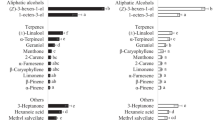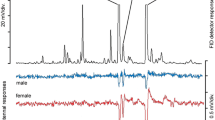Abstract
In a previous study, comparison of the behavior of teneral Glossina morsitans morsitans on waterbuck, Kobus defassa (a refractory host), and on two preferred hosts, buffalo, Syncerus caffer, and ox, Bos indicus, suggested the presence of allomones in the waterbuck odor. Examination of the volatile odors by coupled gas chromatography–electroantennographic detection showed that the antennal receptors of the flies detected constituents common to the three bovids (phenols and aldehydes), as well as a series of compounds specific to waterbuck, including C8C13 methyl ketones, δ-octalactone, and phenols. In this study, behavioral respones of teneral G. m. morsitans to different blends of these compounds were evaluated in a choice wind tunnel. The flies' responses to known or putative attractant blends (the latter comprising EAG-active constituents common to all three animals and those common to buffalo and ox, excluding the known tseste attractants, 4-methylphenol and 3-n-propylphenol), and to putative repellent (the blend of EAG-active compounds specific to the waterbuck volatiles), were different. A major difference related to their initial and final behaviors. When a choice of attractant blends (known or putative) and clean air was presented, flies initially responded by flying upwind toward the odor source, but later moved downwind and rested on either side of the tunnel, with some preference for the side with the odor treatments. However, when presented with a choice of waterbuck-specific blend (putative repellent) and clean air, the flies' initial reaction appeared random; flies flew upwind on either side, but eventually settled down on the odorless side of the tunnel. Flies that flew up the odor plume showed an aversion behavior to the blend. The results lend further support to previous indications for the existence of a tsetse repellent blend in waterbuck body odor and additional attractive constituents in buffalo and ox body odors.
Similar content being viewed by others
References
Baylis, M. 1996. Effects of defensive behaviour by cattle on the feeding success and nutritional state of the tsetse fly, Glossina pallidipes (Diptera: Glossinidae). Bull. Entomol. Res. 86:329–336.
Brady, J. 1975. “Hunger” in the tsetse fly: The nutritional correlates of behaviour. J. Insect Physiol. 21:807–829.
Brady, J., Packer, M. J., and Gibson, G. 1990. Odour plume shape and host finding by tsetse. Insect Sci. Applic. 11:377–384.
Brightwell, R., Dransfield, R. D., and Kyorku, C. A. 1991. Development of a low-cost tsetse trap and odour baits for Glossina pallidipes and G. longipennis in Kenya. Med. Vet. Entomol. 5:153–164.
Bursell, E. 1984. Effects of host odours on the behavior of tsetse. Insect Sci. Applic. 5:345–349.
Bursel, E. 1987. The effect of wind-borne odours on the direction of flight in tsetse flies, Glossina spp. Physiol. Entomol. 12:149–156.
Bursell, E., Gough, A. J. E., Beevor, P. S., Cork, A., Hall, D. R., and Vale, G. A. 1988. Identification of components of cattle urine attractive to tsetse flies, Glossina spp. (Diptera: Glossinidae). Bull. Entomol. Res. 78:281–291.
Chorley, T. W. 1948. Glossina pallidipes Austen attracted by scent of cattle-dung and urine (Diptera). Proc. R. Ent. Soc. Lond. Ser. A 23:9–11.
Clausen, P. H., Adeyemi, I., Bauer, B., Breloeer, M., Salchow, F., and Staak, C. 1998. Host preferences of tsetse flies (Diptera: Glossinidae) based on bloodmeal identifications. Med. Vet. Entomol. 12:169–180.
Colvin, J., Brady, J., and Gibson, G. 1989. Visually guided, upwind turning behaviour of free flying tsetse flies in odour-laden wind: A wind tunnel study. Physiol. Entomol. 14:31–39.
Davis, E. E. 1985. Insect repellents: Concepts of their mode of action relative to potential sensory mechanisms in mosquitoes (Diptera: Culicidae). J. Med. Entomol. 22:237–243.
Dethier, V. G., Browne, L. N., and Smith, C. N. 1960. The designation of chemicals in terms of the responses they elicit from insects. J. Econ. Entomol. 53:134–136.
Dusenbery, D. B. 1989. Optimal search direction for an animal flying or swimming in a wind or current. J. Chem. Ecol. 15: 2511–2519.
Gibson, G. and Brady, J. 1988. Flight behaviour of tsetse flies in host odour plumes: The initial response to leaving or entering odour. Physiol. Entomol. 13:29–42.
Gibson, G., Packer, M. J., Steullet, P., and Brady, J. 1991. Orientation of tsetse flies to wind, within and outside host odor plumes in the field. Physiol. Entomol. 16:47–56.
Gikonyo, N. K., Hassanali, A., Njagi, P. G. N., Gitu, P. M., and Midiwo, J. O. 2002. Odor composition of preferred (buffalo and ox) and nonpreferred (waterbuck) hosts of some savanna tsetse flies. J. Chem. Ecol. 28:961–973.
Gikonyo, N. K., Hassanali, A., Njagi, P. G. N., and Saini, R. K. 2000. Behavior of Glossina morsitans morsitans Westwood (Diptera: Glossinidae) on waterbuck Kobus defassa Ruppel and feeding membranes smeared with waterbuck sebum indicates the presence of allomones. Acta Trop. 77:295–303.
Gouteux, J. P., Blanc, F., Cuisance, D., D'amico, F., and Guinza, A. K. 1995. Trials of olfactory attractants to enhance trap catches of Glossina fuscipes fuscipes (Diptera: Glossinidae) in the Central African Republic. Vet. Res. 26:335–340.
Grootenhuis, J. G. 1986. Trypanotolerance in wildlife. Kenya Veterinar. 10:45–46.
Grootenhuis, J. G. and Olubayo, R. O. 1993. Disease research in the wildlife-livestock interface in Kenya. (Review papers). Vet. Quart. 15:55–59.
Hall, D. R., Beevor, P. S., Cork, A., Nesbitt, B. F., and Vale, G. A. 1984. 1–Octen-3–ol. A potent olfactory stimulant and attractant for tsetse isolated from cattle odours. Insect Sci. Appl. 5:335–339.
Hargrove, J. W. 1976. The effect of human presence on the behaviour of tsetse (Glossina spp.) (Diptera: Glossinidae) near a stationary ox. Bull. Entomol. Res. 66:173–178.
Hargrove, J. W., Holloway, M. T. P., Vale, G. A., Gough, A. J. E., and Hall, D. R. 1995. Catches of tsetse (Glossina spp.) (Diptera: Glossinidae) from traps and targets baited with large doses of natural and synthetic host odour. Bull. Entomol. Res. 85:215–227.
Hassanali, A., McDowell, P. G., Owaga, M. L. A., and Saini, R. K. 1986. Identification of tsetse attractants from excretory products of a wild host animal, Syncerus caffer. Insect Sci. Applic. 7:5–9.
Holmes, P. H. 1997. New approaches to the integrated control of trypanosomiasis. Vet. Parasit. 71:121–135.
Judd, G. J. R. and Borden, J. H. 1989. Distant olfactory responses of the onion fly Delia antiqua, to host-plant odor in the field. Physiol. Entomol. 14: 429–441.
Langley, P. A. and Wall, R. 1990. The implications of hunger in the tsetse fly, Glossina pallidipes, in relation to its availability to trapping techniques. J. Insect Physiol. 36:903–908.
Leak, S. G. A. 1998. Tsetse Biology and Ecology: Their Role in the Epidemiology and Control of Trypanosomosis. CABI, Wallingford, Oxon, United Kingdom, pp 568.
Lehane, M. J. 1991. Biology of Blood-sucking Insects. Harper Collins Academic, New York, pp 1–5.
Mihok, S., Moloo, S. K., Oden'y, J. O., Bret, R. A., Rakwar, J. G., Munyoki, E., Kiiru, J., and Kyorku, C. A. 1996. Attractiveness of black rhinoceros (Diceros bicornis) to tsetse flies (Glossina spp.) (Diptera: Glossinidae) and other biting flies. Bull. Entomol. Res. 86: 33–41.
Moloo, S. K. 1993. The distribution of Glossina species in Africa and their natural hosts. Insect Sci. Applic. 14:511–527.
Ouden, H. den., Bulsink, A., and Theunissen, J. 1996. Compounds repellent to Delia radicum (L) (Dipterau; Anthomyiidae). J. Appl. Entomology. 120:427–432.
Owaga, M. L. A. 1984. Preliminary observations of the efficacy of olfactory attractants derived from wild hosts of tsetse. Insect Sci. Applic. 5:87–90.
Owaga, M. L. A. 1985. Observations on the efficacy of buffalo urine as a potent olfactory attractant for Glossina pallidipes Austen. Insect Sci. Applic. 6:561–566.
Owaga, M. L. A., Hassanali, A., and McDowell, P. G. 1988. The role of 4–cresol and 3–n-propylphenol in the attraction of tsetse flies to buffalo urine. Insect Sci. Applic. 9:95–100.
Paynter, Q. and Brady, J. 1993. Flight responses of tsetse flies (Glossina) to octenol and acetone vapour in a wind tunnel. Physiol. Entomol. 18:102–108.
Sabelis, M. W. and Schippers, F. 1984. Variable wind directions and anemotactic strategies of searching for an odour plume. Oecologia 63:225–228.
Saini, R. K. and Hassanali, A. 1992. Olfactory sensitivity of tsetse to phenolic kairomones. Insect Sci. Applic. 13:95–104.
Saini, R. K., Hassanali, A., Ahuya, P., Andoke, J., and Nyandat, E. 1993. Close range responses of tsetse flies Glossina morsitans morsitans Westwood (Diptera: Glossinidae) to host body kairomones. Discov. Innovat. 5:149–153.
Sas. 1996. SAS Institute, Cary, North Carolina.
Snow, W. F., Tarimo, S. A., Staak, C., and Butler, L. 1988. The feeding habits of the tsetse, Glossina pallidipes Austen on the south Kenya coast, in the context of its host range and trypanosome infection rates in other parts of East Africa. Acta Trop. 45:339–349.
Sutcliffe, J. F. 1987. Distance orientation of biting flies to their hosts. Insect Sci. Applic. 8:611–616.
Torr, S. J. 1988a. The activation of resting tsetse flies (Glossina) in response to visual and olfactory stimuli in the field. Physiol. Entomol. 13: 315–325.
Torr, S. J. 1988b. Behaviour of tsetse flies (Glossina) in host odour plumes in the field. Physiol. Entomol. 13:467–478.
Torr, S. J. 1989. The host-orientated behaviour of tsetse flies (Glossina): The interaction of visual and olfactory stimuli. Physiol. Entomol. 14:325–340.
Torr, S. J., Hall, D. R., and Smith, J. L. 1995. Responses of tsetse flies (Diptera: Glossinidae) to natural and synthetic ox odours. Bull. Entomol. Res. 85:157–166.
Torr, S. J. and Mangwiro, T. N. C. 1996. Upwind flight of tsetse (Glossina spp.) in response to natural and synthetic host odour in the field. Physiol. Entomol. 21:143–150.
Torr, S. J., Mangwiro, T. N. C., and Hall, D. R. 1996. Responses of Glossina pallidipes (Diptera: Glossinidae) to synthetic repellents in the field. Bull. Entomol. Res. 86:609–616.
Turner, D. A. 1987. The population ecology of Glossina pallidipes Austen (Diptera: Glossinidae) in the Lambwe Valley, Kenya. I. Feeding behaviour and activity patterns. Bull. Entomol. Res. 77:317–333.
Vale, G. A. 1974a. The responses of tsetse flies (Diptera: Glossinidae) to mobile and stationary baits. Bull. Entomol. Res. 64:545–588.
Vale, G. A. 1974b. Direct observations on the responses of tsetse flies (Diptera: Glossinidae) to hosts. Bull. Entomol. Res. 64:589–594.
Vale, G. A. 1981. An effect of host diet on the attraction of tsetse flies (Diptera: Glossinidae) to host odour. Bull. Entomol. Res. 71:259–265.
Vale, G. A. 1980. Field studies of the responses of tsetse flies (Glossinidae) and other Diptera to carbon dioxide, acetone and other chemicals. Bull. Entomol. Res. 70:563–570.
Vale, G. A., Flint, S., and Hall, D. R. 1986. The field responses of tsetse flies, Glossina spp. (Diptera: Glossinidae), to odours of host residues. Bull. Entomol. Res. 76:685–693.
Vale, G. A. and Hall, D. R. 1985a. The role of 1–octen-3–ol, acetone and carbon dioxide in the attraction of tsetse flies, Glossina spp. (Diptera: Glossinidae), to ox odour. Bull. Entomol. Res. 75:209–217.
Vale, G. A. and Hall, D. R. 1985b. The use of 1–octen-3–ol, acetone and carbon dioxide to improve baits for tsetse flies, Glossina spp. (Diptera: Glossinidae). Bull. Entomol. Res. 75:219–231
Vale, G. A., Hall, D. R., and Gough, A. J. E. 1988. The olfactory responses of tsetse flies, Glossina spp. (Diptera: Glossinidae), to phenols and urine in the field. Bull. Entomol. Res. 78:293–300.
Warnes, M. L. 1990. Responses of Glossina morsitans morsitans Westwood and G. pallidipes Austen (Diptera: Glossinidae) to the skin secretions of oxen. Bull. Entomol. Res. 80:91–97.
Weitz, B. 1963. The feeding habits of Glossina. Bull. World Health Organ. 29:711–729.
Willemse, L. P. M. 1991. A trial of odour baited targets to control the tsetse fly, Glossina morsitans centralis (Diptera: Glossinidae) in west Zambia. Bull. Entomol. Res. 81:351–357.
Willemse, L. P. M. and Takken, W. 1994. Odour-induced host location in tsetse flies (Diptera: Glossinidae). J. Med. Entomol. 31:775–794.
Author information
Authors and Affiliations
Rights and permissions
About this article
Cite this article
Gikonyo, N.K., Hassanali, A., Njagi, P.G.N. et al. Responses of Glossina morsitans morsitans to Blends of Electroantennographically Active Compounds in the Odors of Its Preferred (Buffalo and Ox) and Nonpreferred (Waterbuck) Hosts. J Chem Ecol 29, 2331–2345 (2003). https://doi.org/10.1023/A:1026230615877
Issue Date:
DOI: https://doi.org/10.1023/A:1026230615877




